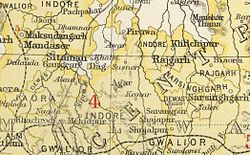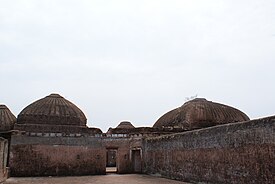Narsinghgarh State
| Narsinghgarh State Parmar Rajput नर्सिन्घ्गढ़ रियासत | |||||||
|---|---|---|---|---|---|---|---|
| Princely State | |||||||
| 1681–1948 | |||||||
 Narsinghgarh State in the Imperial Gazetteer of India | |||||||
| Capital | Narsinghgarh | ||||||
| Area | |||||||
• 1948 | 1,920 km2 (740 sq mi) | ||||||
| Population | |||||||
• 1948 | 140,000 | ||||||
| History | |||||||
| History | |||||||
• Established | 1681 | ||||||
| 1948 | |||||||
| |||||||
Narsinghgarh State[1] is a former princely state of the British Raj in India. It formed an enclave within Rajgarh State and was placed administratively under the Bhopal Agency subdivision of the Central India Agency.[2] The state covered an area of 1,920 square kilometres (740 sq mi) and had a population of 92,093 and an average revenue of Rs.5,00,000 in 1901.[2][3][4]
The capital of state was town of the same name Narsinghgarh.[1]
History[edit | edit source]
The principality was founded in 1681 by a Hindu dynasty whose rulers belonged to the Kshatriya - Parmar clan of Rajputs and claimed descent from Umat, son of Raja Bhoj. The estate was earlier part of Rajgarh State, whose rulers also share same ancestry and from which it was carved as a new estate.[5] The state was a feudatory Jagir to the Holkar rulers of Indore State, but in 1872 Narsinghgarh estate recognized as a state.[6]
After Indian independence in 1947, the rulers of Narsingarh acceded to the Union of India, and the principality was incorporated into the new state of Madhya Bharat in 1948, which subsequently became Madhya Pradesh state on 1 November 1956.
Rulers[edit | edit source]
The rulers of Narsinghgarh State were styled 'Raja', and were entitled to an 11-gun salute.[7]
Rajas[edit | edit source]
- 1872 - Mar 1873 Hanwant Singh (d. 1873)
- 1873 - Apr 1890 Pratap Singh (d. 1890)
- 28 Jun 1890 - 1896 Mahtab Singh (b. 1889 - d. 1896)
- 1896 - 22 Apr 1924 Arjun Singh (b. 1887 - d. 1924) (from 3 Jun 1916, Sir Arjun Singh)
- 23 Apr 1924 – 15 Aug 1947 Vikram Singh (b. 1909 - d. 1957) (from 1 Jan 1941, Sir Vikram Singh)
References[edit | edit source]
- ↑ 1.0 1.1 Imperial Gazetteer of India 1911
- ↑ 2.0 2.1 Chisholm, Hugh, ed. (1911). . Encyclopædia Britannica. Vol. 19 (11th ed.). Cambridge University Press. p. 242.
- ↑ "Imperial Gazetteer2 of India, Volume 8, page 125 -- Imperial Gazetteer of India -- Digital South Asia Library".
- ↑ Narsinghgarh State. 1911. p. 383.
{{cite book}}:|work=ignored (help) - ↑ "Narsinghgarh". Archived from the original on 7 February 2011. Retrieved 28 June 2013.
- ↑ Princely States of India
- ↑ Rajput Provinces of India - Narsinghgarh



